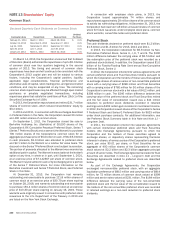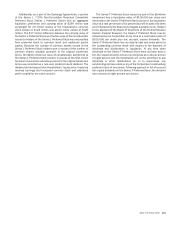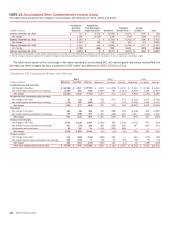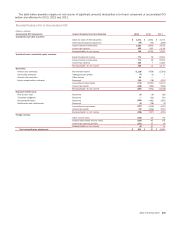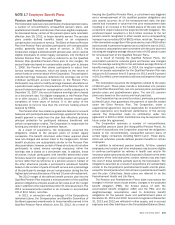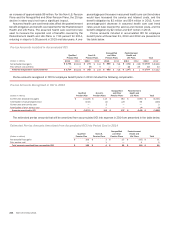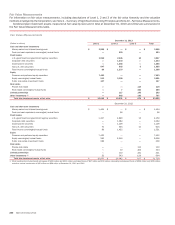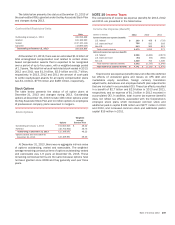Bank of America 2013 Annual Report Download - page 242
Download and view the complete annual report
Please find page 242 of the 2013 Bank of America annual report below. You can navigate through the pages in the report by either clicking on the pages listed below, or by using the keyword search tool below to find specific information within the annual report.240 Bank of America 2013
In July 2013, U.S. banking regulators issued a notice of
proposed rulemaking to modify the supplementary leverage ratio
minimum requirements under Basel 3 effective in 2018. This
proposal would only apply to BHCs with more than $700 billion in
total assets or more than $10 trillion in total assets under custody.
If adopted, it would require the Corporation to maintain a minimum
supplementary leverage ratio of three percent, plus a
supplementary leverage buffer of two percent, for a total of five
percent. If the Corporation’s supplementary leverage buffer is not
greater than or equal to two percent, then the Corporation would
be subject to mandatory limits on its ability to make distributions
of capital to shareholders, whether through dividends, stock
repurchases or otherwise. In addition, the insured depository
institutions of such BHCs, which for the Corporation would include
primarily BANA and FIA, would be required to maintain a minimum
six percent leverage ratio to be considered “well capitalized.” The
proposal is not yet final and, when finalized, could have provisions
significantly different from those currently proposed.
On January 12, 2014, the Basel Committee issued final
guidance introducing changes to the method of calculating total
leverage exposure under the international Basel 3 framework. The
total leverage exposure was revised to measure derivatives on a
gross basis with cash variation margin reducing the exposure if
certain conditions are met, include off-balance sheet
commitments measured using the notional amount multiplied by
conversion factors between 10 percent and 100 percent
consistent with the general risk-based capital rules and a change
to measure written credit derivatives using a notional-based
approach capped at the maximum loss with limited netting
permitted. U.S. banking regulators may consider the Basel
Committee’s final guidance in connection with the July 2013 NPR.
Basel 3 Liquidity Standards
The Basel Committee has issued two liquidity risk-related
standards that are considered part of the Basel 3 liquidity
standards: the Liquidity Coverage Ratio (LCR) and the Net Stable
Funding Ratio (NSFR). The LCR is calculated as the amount of a
financial institution’s unencumbered, high-quality, liquid assets
relative to the net cash outflows the institution could encounter
under a 30-day period of significant liquidity stress, expressed as
a percentage. The Basel Committee’s liquidity risk-related
standards do not directly apply to U.S. financial institutions
currently, and would only apply once U.S. rules are finalized by the
U.S. banking regulators.
On October 24, 2013, the U.S. banking regulators jointly
proposed regulations that would implement LCR requirements for
the largest U.S. financial institutions on a consolidated basis and
for their subsidiary depository institutions with total assets greater
than $10 billion. Under the proposal, an initial minimum LCR of
80 percent would be required in January 2015, and would
thereafter increase in 10 percentage point increments annually
through January 2017. These minimum requirements would be
applicable to the Corporation on a consolidated basis and at its
insured depository institutions, including BANA, FIA and Bank of
America California, N.A.
On January 12, 2014, the Basel Committee issued for
comment a revised NSFR, the standard that is intended to reduce
funding risk over a longer time horizon. The NSFR is designed to
ensure an appropriate amount of stable funding, generally capital
and liabilities maturing beyond one year, given the mix of assets
and off-balance sheet items. The revised proposal would align the
NSFR to some of the 2013 revisions to the LCR and give more
credit to a wider range of funding. The proposal also includes
adjustments to the stable funding required for certain types of
assets, some of which reduce the stable funding requirement and
some of which increase it. The Basel Committee expects to
complete the NSFR recalibration in 2014 and expects the minimum
standard to be in place by 2018.
Other Regulatory Matters
On February 18, 2014, the Federal Reserve approved a final rule
implementing certain enhanced supervisory and prudential
requirements established under the Dodd-Frank Wall Street
Reform and Consumer Protection Act. The final rule formalizes risk
management requirements primarily related to governance and
liquidity risk management and reiterates the provisions of
previously issued final rules related to risk-based and leverage
capital and stress test requirements. Also, a debt-to-equity limit
may be enacted for an individual BHC if determined to pose a grave
threat to the financial stability of the U.S., at the discretion of the
Financial Stability Oversight Council (FSOC) or the Federal Reserve
on behalf of the FSOC.
The Federal Reserve requires the Corporation’s banking
subsidiaries to maintain reserve balances based on a percentage
of certain deposits. Average daily reserve balance requirements
for the Corporation by the Federal Reserve were $16.6 billion and
$16.3 billion for 2013 and 2012. Currency and coin residing in
branches and cash vaults (vault cash) are used to partially satisfy
the reserve requirement. The average daily reserve balances, in
excess of vault cash, held with the Federal Reserve amounted to
$7.8 billion and $7.9 billion for 2013 and 2012. As of
December 31, 2013 and 2012, the Corporation had cash in the
amount of $6.0 billion and $8.5 billion, and securities with a fair
value of $8.4 billion and $5.9 billion that were segregated in
compliance with securities regulations or deposited with clearing
organizations.
The primary sources of funds for cash distributions by the
Corporation to its shareholders are capital distributions received
from its banking subsidiaries, BANA and FIA. In 2013, the
Corporation received $8.5 billion in dividends from BANA. BANA
and FIA returned capital of $8.7 billion to the Corporation in 2013.
In 2014, BANA can declare and pay dividends of $8.0 billion to
the Corporation plus an additional amount equal to its retained
net profits for 2014 up to the date of any dividend declaration.
The other subsidiary national banks returned capital of $1.4 billion
to the Corporation in 2013. Bank of America California, N.A. can
pay dividends of $396 million in 2014 plus an additional amount
equal to its retained net profits for 2014 up to the date of any
such dividend declaration. The amount of dividends that each
subsidiary bank may declare in a calendar year is the subsidiary
bank’s net profits for that year combined with its retained net
profits for the preceding two years. Retained net profits, as defined
by the OCC, consist of net income less dividends declared during
the period.


